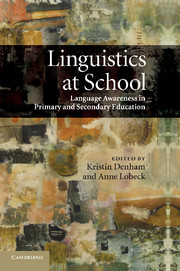Book contents
- Frontmatter
- Contents
- Notes on contributors
- Foreword: The challenge for education
- Introduction
- Part I Linguistics from the top down: encouraging institutional change
- Introduction to Part I
- 1 Ideologies of language, art, and science
- 2 Bringing linguistics into the school curriculum: not one less
- 3 How linguistics has influenced schools in England
- 4 Supporting the teaching of knowledge about language in Scottish schools
- 5 Envisioning linguistics in secondary education: an Australian exemplar
- 6 Linguistics and educational standards: the California experience
- 7 Developing sociolinguistic curricula that help teachers meet standards
- 8 Linguistic development in children's writing: changing classroom pedagogies
- Part II Linguistics from the bottom up: encouraging classroom change
- Part III Vignettes: voices from the classroom
- References
- Index
5 - Envisioning linguistics in secondary education: an Australian exemplar
Published online by Cambridge University Press: 04 August 2010
- Frontmatter
- Contents
- Notes on contributors
- Foreword: The challenge for education
- Introduction
- Part I Linguistics from the top down: encouraging institutional change
- Introduction to Part I
- 1 Ideologies of language, art, and science
- 2 Bringing linguistics into the school curriculum: not one less
- 3 How linguistics has influenced schools in England
- 4 Supporting the teaching of knowledge about language in Scottish schools
- 5 Envisioning linguistics in secondary education: an Australian exemplar
- 6 Linguistics and educational standards: the California experience
- 7 Developing sociolinguistic curricula that help teachers meet standards
- 8 Linguistic development in children's writing: changing classroom pedagogies
- Part II Linguistics from the bottom up: encouraging classroom change
- Part III Vignettes: voices from the classroom
- References
- Index
Summary
Introduction
A fundamental issue in successfully integrating linguistics into the school curriculum is developing a vision of language and linguistics which is relevant to the needs of school learning. While suitably packaging linguistics for study in primary and secondary education may sound simple, it is far from easy and by tradition academic linguists have not been particularly concerned about engaging with the challenge. However, with the relatively recent emergence and recognition within the discipline of ‘educational linguistics’ and a growing acknowledgement within education and society generally in the US, the UK and Australia of the need for knowledge about language to be an integral part of the school curriculum, it is timely to reflect on what linguistics has to offer of value to education and explore ways in which we as linguists can get the study of language and linguistics into schools. For these reasons, this chapter identifies some of the legacies and considerations in elaborating a viable vision of linguistics and describes one example of such a vision that was collaboratively developed and translated into a senior secondary subject with accompanying textbooks in Victoria, Australia.
The subject VCE (Victorian Certificate of Education) English Language (henceforth EL) is the result of university-based linguists and secondary English teachers working from the ‘top down’ to introduce a new subject into the state of Victoria's curriculum.
- Type
- Chapter
- Information
- Linguistics at SchoolLanguage Awareness in Primary and Secondary Education, pp. 62 - 75Publisher: Cambridge University PressPrint publication year: 2010
- 4
- Cited by



